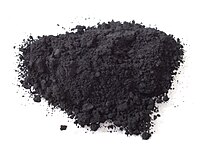
Back أسود الكربون Arabic Вугляродная чэрнь Byelorussian Biljni ugalj BS Negre de carbó Catalan Uhlíková čerň Czech Техникăлла кăмрăкамăш CV Carbon black Danish Ruß German Negro de carbón Spanish Tahm Estonian

| |
| Names | |
|---|---|
Other names
| |
| Identifiers | |
3D model (JSmol)
|
|
| ECHA InfoCard | 100.014.191 |
| EC Number |
|
| E number | E152 (colours) |
| UNII | |
CompTox Dashboard (EPA)
|
|
| |
| Properties | |
| C | |
| Molar mass | 12.011 g·mol−1 |
| Appearance | Black solid |
| Density | 1.8–2.1 g/cm3 (20 °C)[1] |
| Practically insoluble[1] | |
| Hazards | |
| Lethal dose or concentration (LD, LC): | |
LD50 (median dose)
|
> 15400 mg/kg (oral rat)[1] 3000 mg/kg (dermal, rabbit)[1] |
Except where otherwise noted, data are given for materials in their standard state (at 25 °C [77 °F], 100 kPa).
| |

Carbon black (with subtypes acetylene black, channel black, furnace black, lamp black and thermal black) is a material produced by the incomplete combustion of coal tar, vegetable matter, or petroleum products, including fuel oil, fluid catalytic cracking tar, and ethylene cracking in a limited supply of air. Carbon black is a form of paracrystalline carbon that has a high surface-area-to-volume ratio, albeit lower than that of activated carbon. It is dissimilar to soot in its much higher surface-area-to-volume ratio and significantly lower (negligible and non-bioavailable) polycyclic aromatic hydrocarbon (PAH) content.
Carbon black is used as a colorant and reinforcing filler in tires and other rubber products; pigment and wear protection additive in plastics, paints, and ink pigment.[2] It is used in the EU as a food colorant when produced from vegetable matter (E153).
The current International Agency for Research on Cancer (IARC) evaluation is that, "Carbon black is possibly carcinogenic to humans (Group 2B)".[3] Short-term exposure to high concentrations of carbon black dust may produce discomfort to the upper respiratory tract through mechanical irritation.
- ^ a b c d Record in the GESTIS Substance Database of the Institute for Occupational Safety and Health
- ^ "Market Study: Carbon Black". Ceresana. Retrieved 2013-04-26.
- ^ Kuempel, Eileen D.; Sorahan, Tom (2010). "Identification of Research Needs to Resolve the Carcinogenicity of High-priority IARC Carcinogens" (PDF). Views and Expert Opinions of an IARC/NORA Expert Group Meeting, Lyon, France, 30 June – 2 July 2009. IARC Technical Publication No. 42. Lyon, France: International Agency for Research on Cancer. 42: 61–72. Retrieved August 30, 2012.
© MMXXIII Rich X Search. We shall prevail. All rights reserved. Rich X Search